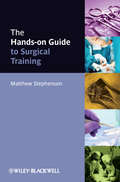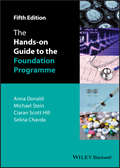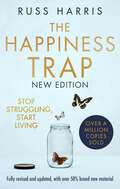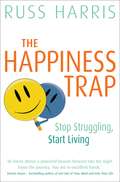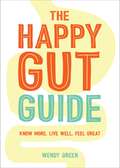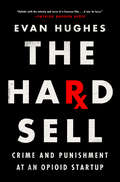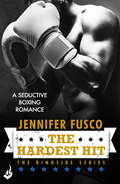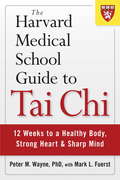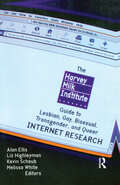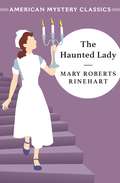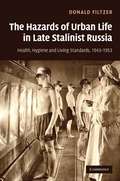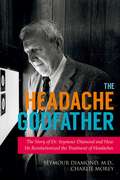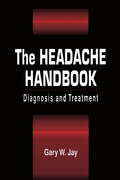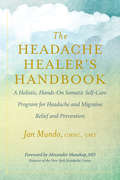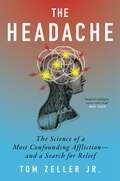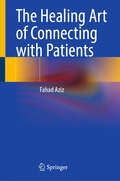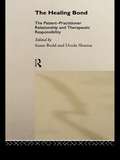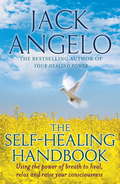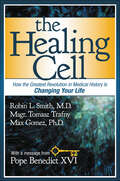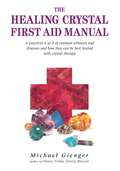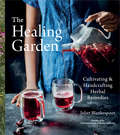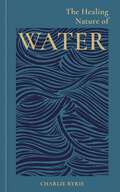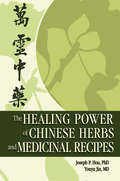- Table View
- List View
The Hands-on Guide to Surgical Training
by Matthew StephensonThinking about a surgical career? About to start surgical training? Do you know what to expect and how to thrive? The Hands-on Guide to Surgical Training is the ultimate, practical guide for medical students and junior doctors thinking about taking the plunge into surgery, and also for surgical trainees already in training. It's full of invaluable, practical information and career guidance to ensure you get the most out of your surgical career. It offers general guidance and advice on surgical training, together with detailed information on each of the nine surgical subspecialties, each written by seniors and consultants, as you make both clinical and career-based choices. Undoubtedly one of the most comprehensive resources for surgical trainees available, The Hands-on Guide to Surgical Training will be essential reading throughout your training and surgical career. Take the stress out of surgical training with The Hands-on Guide!
The Hands-on Guide to the Foundation Programme
by Anna Donald Ciaran Scott Hill Mike Stein Selina ChavdaAbout to start the Foundation Programme?Making the transition from medical school to professional life?The Hands-on Guide to the Foundation Programme, Fifth Edition is a practical guide for medical students and foundation doctors, dealing with the many challenges of the programme. With hints, tips and realistic advice on various aspects of the course, from self-care to prescribing, this guide provides invaluable support, with up-to-date information on postgraduate training and recruitment, practical management skills and career pathways to help build confidence, enabling you to hit the ground running.This edition features newly expanded sections on emergencies, psychiatric evaluation, the Situational Judgement Test, and the common calls and conditions you will encounter on a daily basis. The Hands-on Guide to the Foundation Programme is a perfect companion to assist the junior doctor in preparing for the intellectual and emotional challenges of the foundation years.Take the stress out of the Foundation Programme with The Hands-on Guide!
The Happiness Trap 2nd Edition: Stop Struggling, Start Living
by Russ HarrisTHE MILLION-COPY BESTSELLERDo you ever feel worried, miserable or unfulfilled - yet put on a happy face and pretend everything's fine? You are not alone. Stress, anxiety, depression and low self-esteem are all around. Research suggests that many of us get caught in a psychological trap, a vicious circle in which the more we strive for happiness, the more it eludes us.Fortunately, there is a way to escape from the 'Happiness Trap' in this updated and expanded second edition which unlocks the secrets to a truly fulfilling life. This empowering book presents the insights and techniques of Acceptance and Commitment Therapy (ACT), covering more topics and providing more practical tools than ever before. Learn how to clarify your values, develop self-compassion and find true satisfaction with this bigger and better guide to:· Reducing stress and worry· Handling painful thoughts and feelings more effectively· Breaking self-defeating habits· Overcoming insecurity and self-doubt· Building better relationships· Improving performance and finding fulfilment at workThe Happiness Trap is for everyone. Whether you're lacking confidence, facing illness, coping with loss, working in a high-stress job, or suffering from anxiety or depression, this book will show you how to build authentic happiness, from the inside out.
The Happiness Trap: Stop Struggling, Start Living
by Russ HarrisTHE MILLION COPY BESTSELLERDo you ever feel worried, miserable or unfulfilled - yet put on a happy face and pretend everything's fine? You are not alone. Stress, anxiety, depression and low self-esteem are all around. Research suggests that many of us get caught in a psychological trap, a vicious circle in which the more we strive for happiness, the more it eludes us.Fortunately, there is a way to escape from the 'Happiness Trap', a ground-breaking new approach based on mindfulness skills. Using the six principles of Acceptance and Commitment Therapy (ACT), Russ Harris can help you to:· Reduce stress and worry· Rise above fear, doubt and insecurity· Handle painful thoughts and feelings more effectively· Break self-defeating habits· Improve performance and find fulfilment in your work· Build more satisfying relationships· Create a richer and more meaningful life
The Happy Gut Guide: Know More, Live Well, Feel Great
by Wendy GreenYour gut plays a vital role in your health and happiness. Not only does it contain over 100 million nerves, but it also hosts over 100 trillion bacteria that influence your immune system, weight, mood and general well-being. This book offers easy-to-follow, practical advice on how to have a happy gut and enjoy good health from the inside out.
The Hard Sell: Crime and Punishment at an Opioid Startup
by Evan HughesThe inside story of a band of entrepreneurial upstarts who made millions selling painkillers—until their scheme unraveled, putting them at the center of a landmark criminal trial."A feat of rigorous sleuthing and deft storytelling that unfolds with the velocity and verve of a Scorsese film... A tour de force." —Patrick Radden KeefeJohn Kapoor had already amassed a small fortune in pharmaceuticals when he founded Insys Therapeutics. It was the early 2000s, a boom time for painkillers, and he developed a novel formulation of fentanyl, the most potent opioid on the market. Kapoor, a brilliant immigrant scientist with relentless business instincts, was eager to make the most of his innovation. He gathered around him an ambitious group of young lieutenants. His head of sales—an unstable and unmanageable leader, but a genius of persuasion—built a team willing to pull every lever to close a sale, going so far as to recruit an exotic dancer ready to scrape her way up. They zeroed in on the eccentric and suspect doctors receptive to their methods. Employees at headquarters did their part by deceiving insurance companies. The drug was a niche product, approved only for cancer patients in dire condition, but the company&’s leadership pushed it more widely, and together they turned Insys into a Wall Street sensation. But several insiders reached their breaking point and blew the whistle. They sparked a sprawling investigation that would lead to a dramatic courtroom battle, breaking new ground in the government&’s fight to hold the drug industry accountable in the spread of addictive opioids. In The Hard Sell, National Magazine Award–finalist Evan Hughes lays bare the pharma playbook. He draws on unprecedented access to insiders of the Insys saga, from top executives to foot soldiers, from the patients and staff of far-flung clinics to the Boston investigators who treated the case as a drug-trafficking conspiracy, flipping cooperators and closing in on the key players. With colorful characters and true suspense, The Hard Sell offers a bracing look not just at Insys, but at how opioids are sold at the point they first enter the national bloodstream—in the doctor&’s office.
The Hardest Hit: Ringside 3 (Ringside Series #1)
by Jennifer FuscoWelcome to Vegas. You've got ringside seats to the world's hottest boxing match. Watch fearless champions. Meet the women that knock them off their feet. Fans of Katy Evans, Jamie McGuire and RJ Prescott - let's get ready to ruuummble. Trevor Redding has two families: the boxers at Stamina Gym and the dancers at The Gentlemen's Club, where he works as a bouncer. So when one of the dancers is attacked, he rushes to the rescue, winding up in the hospital himself. Being his own boss, he's not interested in what Dr Chelsea Fox has to say, no matter how stunningly beautiful she is. Concussion or not, he has the biggest fight of his career coming up. Everyone at Stamina is counting on him.When Chelsea discovers that Trevor will do anything to fight, including hiding his diagnosis, she decides to show her roguishly handsome patient who's boss - and just how rewarding it is to follow this doctor's orders.Ready for another round? Don't miss Books One and Two in the series, Fighting For It and Going The Distance.
The Harvard Medical School Guide to Tai Chi: 12 Weeks to a Healthy Body, Strong Heart, and Sharp Mind
by Peter WayneConventional medical science on the Chinese art of Tai Chi now shows what Tai Chi masters have known for centuries: regular practice leads to more vigor and flexibility, better balance and mobility, and a sense of well-being. Cutting-edge research from Harvard Medical School also supports the long-standing claims that Tai Chi also has a beneficial impact on the health of the heart, bones, nerves and muscles, immune system, and the mind. This research provides fascinating insight into the underlying physiological mechanisms that explain how Tai Chi actually works. Dr. Peter M. Wayne, a longtime Tai Chi teacher and a researcher at Harvard Medical School, developed and tested protocols similar to the simplified program he includes in this book, which is suited to people of all ages, and can be done in just a few minutes a day. This book includes: * The basic program, illustrated by more than 50 photographs * Practical tips for integrating Tai Chi into everyday activities * An introduction to the traditional principles of Tai Chi * Up-to-date summaries of the research literature on the health benefits of Tai Chi * How Tai Chi can enhance work productivity, creativity, and sports performance * And much more
The Harvey Milk Institute Guide to Lesbian, Gay, Bisexual, Transgender, and Queer Internet Research
by Alan L Ellis Melissa White Kevin SchaubFind the facts, figures, and connections you need on the Internet!This powerful reference tool is the most comprehensive, reliable guide to Internet resources for the LBGTQ community. More than just a guide to useful Web sites, it also evaluates LGBTQ mailing lists, message boards, search engines, and portals.The Harvey Milk Institute Guide to Lesbian, Gay, Bisexual, Transgender, and Queer Internet Research provides background information as well as useful URLs. It covers the history and objectives of major sites. The in-depth interviews with leaders of the queer Internet include discussions with Barry Harrison, Director of Queer Arts Resources, and Sister Mary Elizabeth, founder of AEGiS.The Harvey Milk Institute Guide to Lesbian, Gay, Bisexual, Transgender, and Queer Internet Research includes resources for a variety of academic disciplines, including:the humanitiesthe social scienceslawlabor studiesmedia studiestransgender and intersex studiesand more!Edited by Alan L. Ellis, co-chair of the institute's board of directors, The Harvey Milk Institute Guide to Lesbian, Gay, Bisexual, Transgender, and Queer Internet Research is an indispensable tool for researchers, community leaders, and scholars.
The Haunted Lady (The\hilda Adams Mysteries Ser. #2)
by Mary Roberts RinehartA very very rich dowager is being scared to death . . .A classic whodunit by a #1 bestselling author who 'helped the mystery series grow up" (New York Times)First a cloud of bats; then rats - it looks like someone is trying to frighten Eliza Fairbanks into her grave. At least that's what the elderly widow claims is being done to her. Nurse Hilda Adams, aka "Miss Pinkerton" to the Homicide Bureau, believes Eliza's fears could just be true . . .And when a dubious assortment of relatives come visiting Eliza at the mansion, it's Hilda's job to keep an eye on Eliza before a potential killer resorts to more definitive means. And considering all the bad blood running through the heart of the Fairbanks family, it might already be too late to save her charge.
The Hazards of Urban Life in Late Stalinist Russia
by Donald FiltzerThis is the first detailed study of the standard of living of ordinary Russians following World War II. It examines urban living conditions under the Stalinist regime with a focus on the key issues of sanitation, access to safe water supplies, personal hygiene and anti-epidemic controls, diet and nutrition, and infant mortality. Comparing five key industrial regions, it shows that living conditions lagged some fifty years behind Western European norms. The book reveals that, despite this, the years preceding Stalin's death saw dramatic improvements in mortality rates thanks to the application of rigorous public health controls and Western medical innovations. While tracing these changes, the book also analyzes the impact that the absence of an adequate urban infrastructure had on people's daily lives and on the relationship between the Stalinist regime and the Russian people, and, finally, how the Soviet experience compared to that of earlier industrializing societies.
The Headache Godfather: The Story of Dr. Seymour Diamond and How He Revolutionized the Treatment of Headaches
by Seymour Diamond Charlie MoreyLearn the story of a man who lived the American dream and improved the quality of life for thousands of headache sufferers.The Headache Godfather traces the life of Seymour Diamond, MD, who was born in 1925, the son of Jewish immigrants from Ukraine and Slovakia, in Chicago, Illinois. Dr. Diamond revolutionized the practice of headache as a medical specialty when he opened the United States' first private headache practice, the Diamond Headache Clinic, in 1974. It quickly became a headache haven for sufferers from around the world. He also established a nonprofit organization, the National Headache Foundation, to support research for headache relief and to spread the knowledge among doctors and headache sufferers alike.At eighty-nine years of age, Dr. Diamond looks back on his battles with the Food and Drug Administration over headache treatments, the political skirmishes with those who would block his will to succeed, his globe-trotting adventures to learn and share current headache knowledge, the hundreds of thankful patients who claim that his headache treatment saved their lives, a frightening and painful malpractice lawsuit, and even a relationship with a Chicago Mafia member whose family Dr. Diamond treated early in his medical career, and who was ultimately found in the trunk of a stolen automobile, shot to death.Seymour Diamond is a living example of an individual who succeeded at living the American dream. Working several jobs while attending college and medical school, applying his intelligence, energy, and imagination to the world of headache medicine, and providing for his wife, Elaine, and their family of three daughters while building an empire of headache health, Seymour Diamond is indeed the Headache Godfather.
The Headache Handbook: Diagnosis and Treatment
by Gary W. JayThe Headache Handbook: Diagnosis and Treatment helps both generalist and specialist clinicians, including family practitioners, chiropractors, and neurologists, to understand headache, possibly the most ubiquitous symptom in medicine. This comprehensive work covers the myriad of differences among headache patients and the need for accurate fact gathering and physical and neurological examinations. Topics include anatomy and physiology of headache; evaluation and treatment of various headache types; interventional procedures; and manual medicine consultations.
The Headache Healer’s Handbook: A Holistic, Hands-On Somatic Self-Care Program for Headache and Migraine Relief and Prevention
by Alexander Mauskop Jan MundoJan Mundo’s mind-body program teaches headache and migraine sufferers how to relieve and prevent their symptoms naturally — without drugs and their side effects. Here she shares her powerful personalized, comprehensive program for the first time. In step-by-step instructions, she helps readers discover and prevent the triggers that perpetuate their headaches — and stop their pain on the spot with her unique hands-on therapy. In a caring and compassionate voice, she makes her techniques accessible to both occasional headache sufferers and those who have long felt misunderstood and misdiagnosed. Brimming with inspirational narratives, questionnaires, guidelines, tracking tools, and author-illustrated instructions, The Headache Healer’s Handbook answers the headache sufferer’s plea for help and offers hope for a headache-free future.
The Headache: The Science of a Most Confounding Affliction—and a Search for Relief
by Tom Zeller Jr."Required reading for anyone with a head."—Mary Roach, New York Times bestselling author of Stiff and Fuzz"[The Headache] weaves together history, biology, a survey of current research, testimony from patients, and an agonizing account of Zeller’s own suffering. . . If there’s a lesson here, it’s that pain resists mastery, but understanding, however incomplete, can offer its own form of relief."—New YorkerFrom blinding migraines to severe headache disorders known as “clusters,” chronic head pain affects 40% of the population, many of them suffering in silence. Finally, The Headache reveals the science behind a group of disorders that is as much a curse as a cultural punchline, and leads to key insights into the nature of pain itself.Guided by his own decades-long struggle with cluster headaches, veteran science journalist Tom Zeller Jr.’s journey into headache science is at once intimate and panoramic. He visits cutting-edge clinics; interviews dozens of doctors, neurologists, and fellow headache patients; participates in clinical trials for multi-million-dollar new medicines; and even experiments with psilocybin in search of relief. Along the way, Zeller traces the longer arc of mystery around headaches, from prehistoric skull surgery to Virginia Woolf’s assertion that, in the throes of a migraine, “language runs dry,” to reveal how headaches became one of the most under-researched afflictions in medicine—and how that is slowly starting to change.With warmth, wit, and infectious curiosity, Zeller’s search for the origins of his own headaches becomes a journey into the inner workings of the human nervous system, and an invaluable witness to one of the most maligned conditions known to medicine.
The Healer's Power
by Howard BrodyAlthough the physician’s use and misuse of power have been discussed in the social sciences and in literature, they have never been explored in medical ethics until now. <p><p>In this book, Dr. Howard Brody argues that the central task is not to reduce the physician’s power, as others have suggested, but to develop guidelines for its use, so that the doctor shares with the patient both information and the responsibility for deciding on appropriate treatment.
The Healing Art of Connecting with Patients
by Fahad AzizThis book provides physicians with a practical, insightful guide on mastering the often-overlooked yet essential skill of patient connection. While clinical expertise is foundational to the medical profession, the ability to build meaningful relationships with patients is equally important for achieving positive outcomes. This book seeks to address the gap in medical education and practice by focusing on the emotional, psychological, and relational dimensions of healthcare. This is an ideal guide for all physicians wanting to improve patient care.
The Healing Bond: The Patient-Practitioner Relationship and Therapeutic Responsibility
by Susan Budd Ursula SharmaThe growing popularity of alternative therapies poses challenging questions for the medical establishment and the state. By confronting these questions, The Healing Bond makes an important contribution to current debates about health care. The contributors, who are all experts in the fields of health care, social science and the law, focus on the relationship between patient and healer in both orthodox and non-orthodox forms of healing practice. They consider whether different forms of healing involve widely differing conceptions of the role and responsibilities of the healer, and deal with topical issues such as medical litigation, codes of ethics for complementary practitioners, and co-operation between orthodox and complementary medicine.
The Healing Breath: How to use the power of breathing to heal, reduce stress and improve wellbeing
by Jack AngeloThe Healing Breath is an inspiring and practical guide to improving and maintaining your spiritual and physical health. Leading UK healer and teacher Jack Angelo unlocks the mysteries of self-healing and shows how the breath is the medium for all healing energies. With over 50 easy-to-follow exercises, meditations, affirmations and visualisations, using the power of breath you can:· Relieve stress and anxiety to attain emotional and mental calm· Increase your energy levels, creativity and mental focus· Improve your meditation skills· Ensure sound sleep, relaxation and healing in all aspects of your life This is essential reading for everyone who wishes to develop spiritual wellbeing, including professional and student healers, complementary therapists and devotees of yoga and t'ai chi.
The Healing Cell: How the Greatest Revolution in Medical History is Changing Your Life
by Max Gomez Robin L. Smith Tomasz TrafnyThe Healing Cell is an easy to read, carefully researched, and clear-eyed view of medicine many decades in the making that is now paying off with treatments that repair damaged hearts, restore sight, kill cancer, cure diabetes, heal burns, and stop the march of such degenerative diseases as Alzheimer's, multiple sclerosis, and Lou Gehrig's disease. The emotionally and intellectually stimulating stories throughout the book dramatically illustrate that stem cell therapies can change the way we live our lives after being afflicted by a disease or trauma. The book is the result of a unique collaboration between the Vatican's Pontifical Council for Culture and the Stem for Life Foundation. It includes a special address by His Holiness Benedict XVI, urging increased support and awareness for advancements in adult stem cell research.
The Healing Crystals First Aid Manual
by Michael GiengerFrom acne and cataracts to sprains and vomiting, this reference lists more than 100 medical conditions and describes the physical symptoms, psychological ramifications, and correct healing gemstones for each. The most effective form of the gem is specified-a polished pocket stone rather than a necklace, for example-and in some cases more than one kind of crystal is described to be effective. A comprehensive appendix with color photos of all prescribed gemstones, a guide to assembling basic home crystal kits, and a bibliography are included.
The Healing Garden: Cultivating and Handcrafting Herbal Remedies
by Juliet BlankespoorA comprehensive and lushly photographed guide to growing and using healing plants, including recipes, from the founder of the Chestnut School of Herbal MedicineThis is the ultimate reference for anyone looking to bring the beauty and therapeutic properties of plants into their garden, kitchen, and home apothecary. Both informative and accessible, it covers how to plan your garden (including container gardening for small spaces); essential information on seed propagation, soil quality, and holistic gardening practices; 30 detailed profiles of must-know plants (including growing information, medicinal properties, and how to use them); foundational principles of herbalism; step-by-step photographic tutorials for preparing botanical medicine and healing foods; and 70 recipes for teas, tinctures, oils, salves, syrups, and more. Packed with sumptuous photography, this book will appeal to home gardeners who want to branch out to culinary and medicinal herbs, home cooks and those interested in natural wellness, and novice and skillful herbalists alike.
The Healing Nature of Water
by Charlie RyrieWhat element is more fundamental to life than water? It flows through our existence, carrying the essence of life itself in its currents. Water is the silent mediator between life and death, health and sickness, and it sustains our very existence.In a world increasingly aware of water's vulnerability - amidst news of polluted rivers and widespread water scarcity - understanding and preserving its healing power has never been more crucial. This book invites you to discover water's intrinsic power, following the diverse paths of water's journey, offering insights into harnessing its restorative properties to enhance health, boost well-being, and align more harmoniously with our environment. This captivating book reveals how our connection with water transcends the physical realm, resonating deeply within our subconscious and spiritual selves. The Healing Nature of Water is your essential guide to unlocking water's energy for personal and environmental resilience.Chapters include:- Sacred water- Water for life- Using water's vital energies
The Healing Nature of Water
by Charlie RyrieWhat element is more fundamental to life than water? It flows through our existence, carrying the essence of life itself in its currents. Water is the silent mediator between life and death, health and sickness, and it sustains our very existence.In a world increasingly aware of water's vulnerability - amidst news of polluted rivers and widespread water scarcity - understanding and preserving its healing power has never been more crucial. This book invites you to discover water's intrinsic power, following the diverse paths of water's journey, offering insights into harnessing its restorative properties to enhance health, boost well-being, and align more harmoniously with our environment. This captivating book reveals how our connection with water transcends the physical realm, resonating deeply within our subconscious and spiritual selves. The Healing Nature of Water is your essential guide to unlocking water's energy for personal and environmental resilience.Chapters include:- Sacred water- Water for life- Using water's vital energies
The Healing Power of Chinese Herbs and Medicinal Recipes
by Joseph P. Hou Youyu JinA modern reference guide on the benefits of incorporating traditional Chinese medicine into modern-day therapies!The Healing Power of Chinese Herbs and Medicinal Recipes is an easy-to-follow introduction to the history of traditional Chinese phytomedicine. This useful guide clearly explains the basics of this unique medical system and describes in detail the therapeutic properties and use of medicinal herbs and herbal recipes. The book includes a bibliography, glossary, contact information for herbal dealers and Oriental medicine schools, and an indexed list of 300 commonly used Chinese medicinal herbs and 245 herbal recipes. In The Healing Power of Chinese Herbs and Medicinal Recipes, you will find the fundamentals, evolution, and development of the herbal formulas of the 4,000-year-old Oriental Materia Medica, also known as ben cao. The book contains 11 sections documenting the therapeutic applications, dosages, precautions, and modern research findings of 138 of the most popular medicinal herbs. In addition, this resource provides 101 of the most frequently prescribed master recipes by famous ancient physicians, including their origin, ingredients, actions, indications, and modern clinical uses. The Healing Power of Chinese Herbs and Medicinal Recipes offers an in-depth education on: tonic herbs herbs that adjust the yin and yang of the body herbs that invigorate circulation of vital energy, qi, and blood herbal tranquilizers herbal diaphoretics herbal expectorants, antitussives, and antiasthmatics herbal pain killers herbs which regulate digestion and elimination herbal diuretics herbal antipyretics, antimicrobials, and detoxicants antitumor herbs The Healing Power of Chinese Herbs and Medicinal Recipes provides up-to-date information on the effectiveness of traditional Chinese medicine, as well as how to use Chinese medicinal herbs in conjunction with Western conventions. This comprehensive reference will benefit healthcare practitioners who want to include Oriental medicine in their practice, and anyone who is interested in Chinese herbs or patients for whom conventional medicine has offered no relief.
